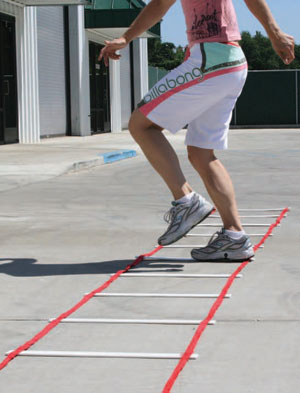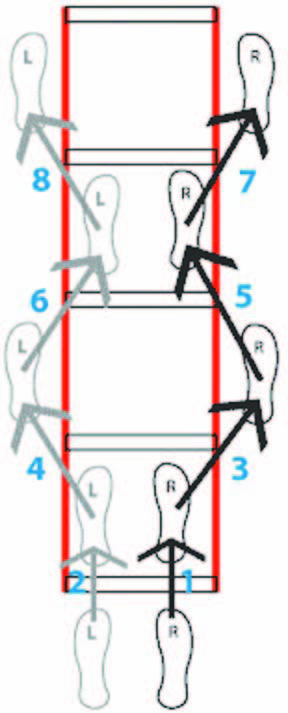The Agility Ladder

The warm-up process we use at NorCal Strength & Conditioning has gone through many evolutions over the past few years. We have used iterations of the CrossFit Warm-up©, running, rowing and jump rope with varying levels of interest and success. At present we use a mono-structural warm-up, typically a run or row followed by dynamic range of movement activities, and one of the following: The Burgner Warm-up or Hatch Warm-up and recently the addition of agility ladder work.

The agility ladder is a tool that I have approached with open disdain in the past. I’ve seen some top dollar facilities, naming no names (Speed/Time perhaps?), use the agility ladder as if it were the cure for cancer while the athletes these folks train are tragically weak and lacking in general conditioning. I have to admit that the combination of bad tool usage (the agility ladder) and bad programming (have these folks heard of Back squats? DB cleans?) Really soured me to agility work. Well…my eyes have been opened. Zach Davis was perhaps the first person to show me the value of agility ladder work in the context of a smart S&C program. Zach used the ladder amidst warm-ups and at various points in the workout when fatigue could make agility work challenging. Good stuff. We have started using this in our warm-ups and the clients love them…and I know it is benefiting their fine motor control and agility. I spoke a little with Tyler Hass about the agility ladder and who it would most benefit from its use. Not surprisingly he said “Someone who is already strong and powerful…but who lacks agility in the lower extremities”. Sounds familiar, strength before strength endurance and strength before agility work. Seems like some Russians have said something to that effect at one time or another, but hey! what do the Ruskies know?
I highly recommend the inclusion of agility ladder work for your warm-up or the warm-up you have planned for your clients or athletes. Not only will they like it but they will benefit from the relaxed yet fast paced movements, increase in core temperature and quick progress they (and perhaps you) will make on the movements. Tyler was kind enough to share some of the skills that are detailed in the manual that accompanies his agility ladder. This is the best ladder I have seen and the will get you up and dancing. Give it a shot and let us know how it’s going on the Performance Menu Speed & Agility Forum.
In this guide, the black arrow represents your lead leg. And the grey arrow represents the trailing leg. These patterns are all shown with the right leg beginning as the lead leg, but each pattern is reversible.
Basic Pattern
The most basic pattern is to step one foot into each ladder.
1. Step your lead leg into the first rung.
2. Step your trailing leg into the second rung.
3. Step your lead leg into the third rung.
4. Step your trailing leg into the fourth rung.
Repeat pattern.

Double Step Pattern
In this pattern, both feet will enter each rung.
1. Lead leg steps into first rung.
2. Trailing leg steps into first rung.
3. Lead leg steps into second rung.
4. Trailing leg steps into second rung.
Repeat pattern.

Basic In-Out Pattern
In this pattern, we will be stepping outside of the rungs on alternating steps.
1. Lead leg into first rung.
2. Trailing leg into first rung.
3. Lead leg outside second rung.
4. Trailing leg outside second rung.
5. Lead leg into third rung.
6. Trailing leg into third rung.
Repeat pattern.


The agility ladder is a tool that I have approached with open disdain in the past. I’ve seen some top dollar facilities, naming no names (Speed/Time perhaps?), use the agility ladder as if it were the cure for cancer while the athletes these folks train are tragically weak and lacking in general conditioning. I have to admit that the combination of bad tool usage (the agility ladder) and bad programming (have these folks heard of Back squats? DB cleans?) Really soured me to agility work. Well…my eyes have been opened. Zach Davis was perhaps the first person to show me the value of agility ladder work in the context of a smart S&C program. Zach used the ladder amidst warm-ups and at various points in the workout when fatigue could make agility work challenging. Good stuff. We have started using this in our warm-ups and the clients love them…and I know it is benefiting their fine motor control and agility. I spoke a little with Tyler Hass about the agility ladder and who it would most benefit from its use. Not surprisingly he said “Someone who is already strong and powerful…but who lacks agility in the lower extremities”. Sounds familiar, strength before strength endurance and strength before agility work. Seems like some Russians have said something to that effect at one time or another, but hey! what do the Ruskies know?
I highly recommend the inclusion of agility ladder work for your warm-up or the warm-up you have planned for your clients or athletes. Not only will they like it but they will benefit from the relaxed yet fast paced movements, increase in core temperature and quick progress they (and perhaps you) will make on the movements. Tyler was kind enough to share some of the skills that are detailed in the manual that accompanies his agility ladder. This is the best ladder I have seen and the will get you up and dancing. Give it a shot and let us know how it’s going on the Performance Menu Speed & Agility Forum.
In this guide, the black arrow represents your lead leg. And the grey arrow represents the trailing leg. These patterns are all shown with the right leg beginning as the lead leg, but each pattern is reversible.
Basic Pattern
The most basic pattern is to step one foot into each ladder.
1. Step your lead leg into the first rung.
2. Step your trailing leg into the second rung.
3. Step your lead leg into the third rung.
4. Step your trailing leg into the fourth rung.
Repeat pattern.

Double Step Pattern
In this pattern, both feet will enter each rung.
1. Lead leg steps into first rung.
2. Trailing leg steps into first rung.
3. Lead leg steps into second rung.
4. Trailing leg steps into second rung.
Repeat pattern.

Basic In-Out Pattern
In this pattern, we will be stepping outside of the rungs on alternating steps.
1. Lead leg into first rung.
2. Trailing leg into first rung.
3. Lead leg outside second rung.
4. Trailing leg outside second rung.
5. Lead leg into third rung.
6. Trailing leg into third rung.
Repeat pattern.

| Robb Wolf is the author of the best-selling book The Paleo Solution, co-founder of the Performance Menu, and co-owner of NorCal Strength & Conditioning. |
Search Articles
Article Categories
Sort by Author
Sort by Issue & Date
Article Categories
Sort by Author
Sort by Issue & Date

